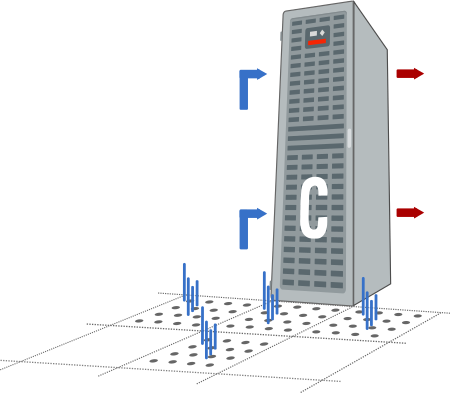1.7 Ventilation and Cooling
Learn about the ventilation and cooling requirements for OPCM and the optional ZS3 storage expansion rack.
Always provide adequate space in front of and behind the rack to allow for proper ventilation. Do not obstruct the front or rear of the rack with equipment or objects that might prevent air from flowing through the rack. Rack-mountable servers and equipment typically draw cool air in through the front of the rack and let warm air out the rear of the rack. There is no air flow requirement for the left and right sides due to front-to-back cooling.
If the rack is not completely filled with components, the empty sections will be covered with filler panels. Gaps between components can adversely affect air flow and cooling within the rack.
Relative humidity is the percentage of the total water vapor that can exist in the air without condensing, and is inversely proportional to air temperature. Humidity goes down when the temperature rises, and goes up when the temperature drops. For example, air with a relative humidity of 45 percent at a temperature of 24 degrees Celsius (75 degrees Fahrenheit) has a relative humidity of 65 percent at a temperature of 18 degrees Celsius (64 degrees Fahrenheit). As the temperature drops, the relative humidity rises to more than 65 percent, and water droplets are formed.
Air conditioning facilities usually do not precisely monitor or control temperature and humidity throughout an entire computer room. Generally, monitoring is done at individual points corresponding to multiple exhaust vents in the main unit, and other units in the room. Special consideration should be paid to humidity when using underfloor ventilation. When underfloor ventilation is used, monitoring is done at each point close to an exhaust vent. Distribution of the temperature and humidity across the entire room is uneven.
Oracle Public Cloud Machine (OPCM) systems have been designed to function while mounted in a natural convection air flow. The following requirements must be followed to meet the environmental specification:
-
Ensure there is adequate air flow through the server.
-
Ensure the server has front-to-back cooling. The air inlet is at the front of the server, and the air is let out the rear.
-
Allow a minimum clearance of 914 mm (36 inches) at the front of the server, and 914 mm (36 inches) at the rear of the server for ventilation.
Use perforated tiles, approximately 400 CFM/tile, in front of the rack for cold air intake. The tiles can be arranged in any order in front of the rack, as long as cold air from the tiles can flow into the rack. Inadequate cold air flow could result in a higher inlet temperature in the servers due to exhaust air recirculation. The following is the recommended number of floor tiles:
-
Four floor tiles for OPCM model 1080.
-
Three floor tiles for OPCM model 576.
-
One floor tile for OPCM model 288.
The following figure shows an installation of the floor tiles for an OPCM model 1080 in a typical data center.
Figure 1-2 Typical Data Center Configuration for Perforated Floor Tiles

The following table describes the cooling and airflow maximum and typical requirements for OPCM:
Table 1-13 Cooling and airflow requirements for OPCM
| Description | Model 288 | Model 576 | Model 1080 |
|---|---|---|---|
| Maximum cooling | 26397 BTU/hour, 27849 kJ/hour | 45898 BTU/hour, 48422 kJ/hour | 80297 BTU/hour, 84714 kJ/hour |
| Typical cooling | 18478 BTU/hour, 19494 kJ/hour | 32128 BTU/hour, 33896 kJ/hour | 56208 BTU/hour, 59300 kJ/hour |
| Maximum airflow (front to back) | 1222 CFM | 2125 CFM | 3717 CFM |
| Typical airflow (front to back) | 855 CFM | 1487 CFM | 2602 CFM |
If you are deploying the OPCM ZS3 storage expansion rack, review the following table describing cooling requirements:
Table 1-14 Cooling requirements for OPCM ZS3 Storage Expansion Rack
| Description | Model 268 | Model 536 |
|---|---|---|
| Maximum cooling | 22759 BTU/hour, 24012 kJ/hour | 45518 BTU/hour, 48024 kJ/hour |
| Typical cooling | 10834 BTU/hour, 11430 kJ/hour | 21668 BTU/hour, 22860 kJ/hour |